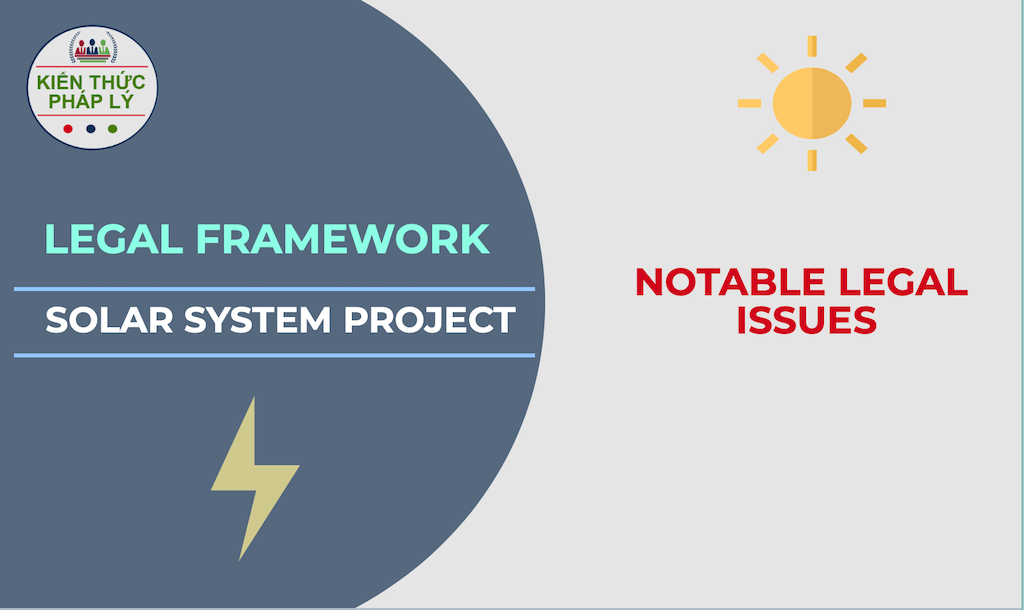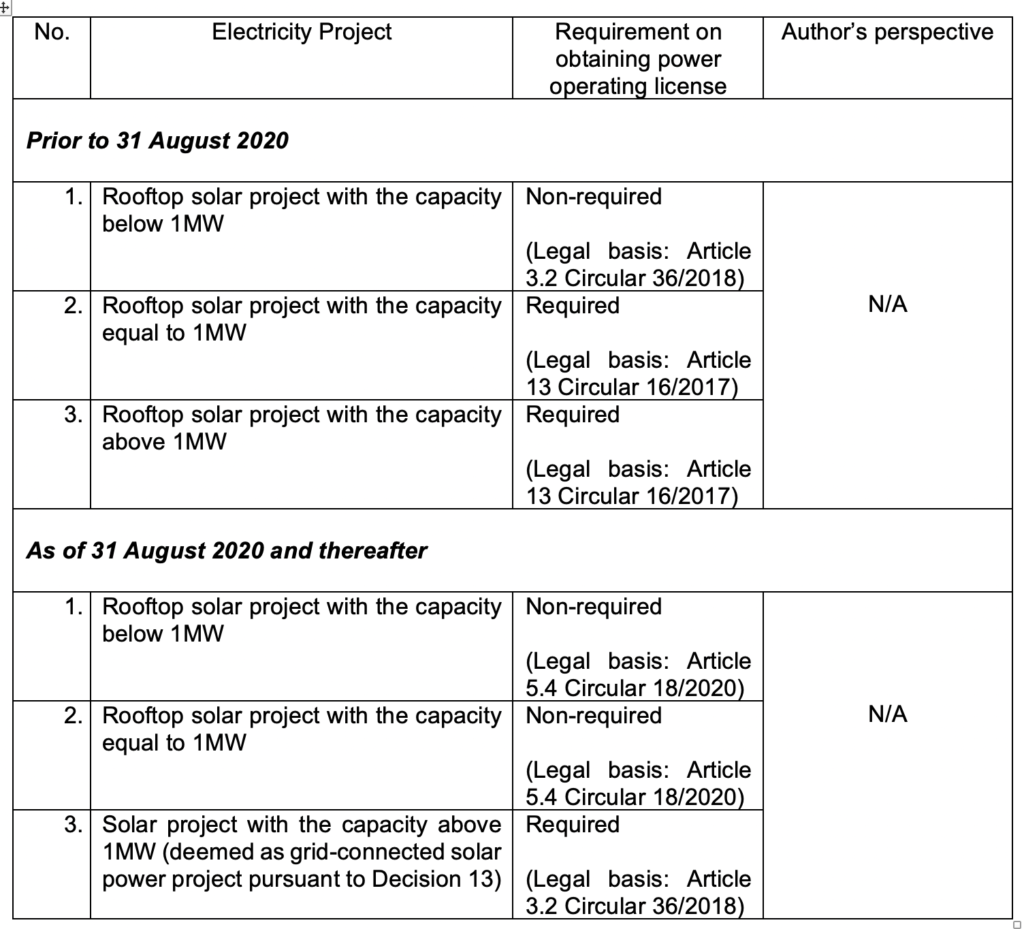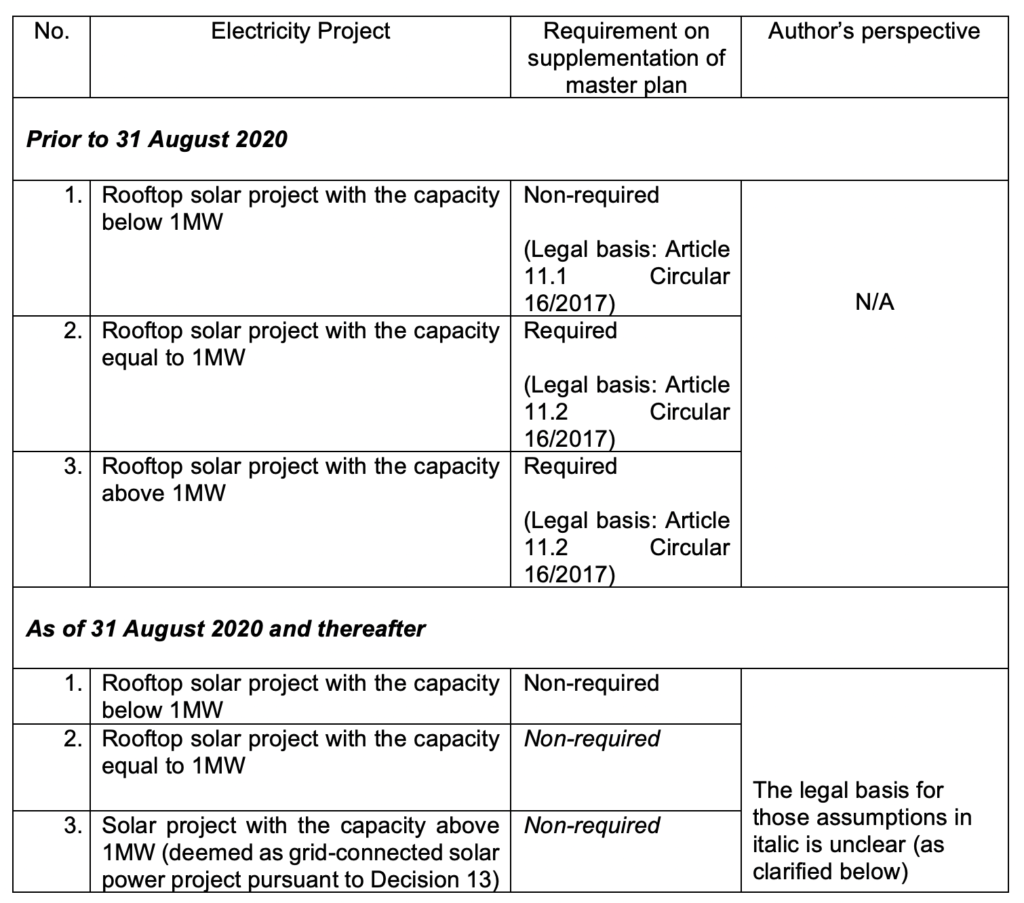The solar system project is absorbing significant investment from the local as well as foreign investors. Nevertheless, despite numerous legislations having been made available in an attempt to erect the legal framework for the solar system project (from Decision of the Prime Minister to the Circulars of the Ministry of Industry and Trade), the provisions therein are inconsistent and unclear which truncate its enforceability.
This article shall concentrate on demonstrating, analyzing, and presenting the practical law application of the competent authorities rooted from the author’s personal experience in rendering legal advice for the rooftop solar system project (RSSP)[1].

See the Vietnamese article HERE.
The lack of clarity in the definition of the rooftop solar system project
The definition of rooftop solar system project is provided under Article 3.5 of Decision 13/2020/QD-TTg (“Decision 13/2020”) which reads:
“The rooftop solar system means the solar system in which the solar panels are installed on the roof of the construction with the capacity of no more than 1MW and directly or indirectly connected to the power grid of 35kV and below of the Buyers”
Such a definition seems quite straight-forward but it actually confuses the competent authorities in practice.
First, with respect to the requirement on “the solar panels are installed on the roof of the construction”, (1) could a project be a rooftop solar project if a minimal number of solar panels are installed on the ground while a majority of them is installed on the roof of the construction, or (2) could a project be a rooftop solar project if the solar panels being installed also play the role of a roof?[2]
Despite the lack of comprehensive guidelines, the State authorities as well as the Electricity Vietnam Corporation (EVN) seem to adopt the restrictive approach. It means that (1) ALL the solar panels of a rooftop solar system project must be installed on the roof of the construction. Put it differently, a solar project which contains any single solar panel being installed on the ground shall not be deemed a rooftop solar project. In addition, the term “construction” used in such a definition refers to a fully-built building of which the construction status must adapt to the construction requirements prescribed by laws; and (2) the solar panels must be installed on a fully-completed roof of a construction building. In short, the answers to both aforesaid questions are simply “No”.
Second, with respect to the requirement on “no more than 1MW”, this can be explained in a way that the installed power capacity of a rooftop solar project must be below 1 MW or equal to 1 MW. However, such a maximum power capacity confuses the State authorities when considering which project requires the power operating license.
To clarify, article 5.4 of Circular 18/2020/TT-BCT (in effect as of 31 August 2020) (“Circular 18/2020”) reads:
“The rooftop solar system shall be exempt from power operating license.”
Be that as it may, even when Circular 18/2020 comes into force, another Circular of Ministry of Industry and Trade (MOIT) remains in full effect – that is Circular 36/2018/TT-BCT providing guidelines on the sequence and procedures for the issuance, withdrawal of the power operating license (“Circular 36/2018”) of which literature is as follows[3]:
“Article 3: Exemption of power operating license
1. To generate electricity for self-usage without selling to other individuals or organizations.
2. To generate electricity with the installed capacity of less than 1MW (1MWp with respect to the solar plant at a single location and per a connection point) to sell to other individuals or organizations.
3. To conduct electricity trading in the rural, mountainous, island regions by purchasing electricity with the capacity of less than 50kVA from the electricity distribution network to directly supply electricity to the customers in such rural, mountainous, island regions.
4. To perform national electrical load dispatch and to manage the transactions on electricity market.”
Accordingly, the rooftop solar system project of which the capacity is equal to 1MW shall not be exempt from the power operating license.
In principle, since Circular 18/2020 is the later legislation, if one matter is governed in different directions by Circular 18/2020 and Circular 36/2018, the provision stipulated by Circular 18/2020 shall prevail. Nevertheless, as Circular 36/2018 is the specific legislation directly governing the issuance of power operating license, the MOIT should have amended such Circular to reflect the intention of Decision 13/2020 as well as Circular 18/2020 to avoid unnecessary difficulties in applying legislation in practice.
As from 31 August 2020 (upon the effect of Circular 18/2020), debates surrounding the inconsistencies between different legislations providing for the requirement on power operating license may be settled. However, at this juncture when Circular 18/2020 has not yet legally come into force and replaced Circular 16/2017/TT-BCT (“Circular 16/2017”), the practical debates on which Circular to finally be read in light of the requirement on obtaining a power operating license seem to be open-ended. To date of this article, Circular 16/2017 (which will be replaced by Circular 18/2020 as of 31 August 2020) currently provides that[4]:
“Article 13: Requirement on power operating license
The grid-connected solar power project, rooftop solar power project of which the capacity is equal to or more than 01 (one) MW must obtain the power operating license, and comply with the requirements prescribed by Circular 12/2017/TT-BCT dated 31 July 2017 of the Ministry of Industry and Trade”.
Therefore, from the author’s perspective and for the sake of the investor, it is imperative that any 1MW solar project to be set up at the moment must obtain the power operating license in accordance with Circular 36/2018 and Circular 16/2017.
In general, the obtainment of power operating license should be conducted as clarified in the below table.

Supplementation of electricity master plan: Is it still required?
Article 11.2 of Circular 16/2017 provides that:
“2. With respect to the rooftop solar project of which the capacity is equal to or above 01 (one) MW, Investor of the rooftop solar project must carry out the procedures for supplementing solar development master plan and electricity development master plan pursuant to Article 9 herein.”
The phrase “rooftop solar project of which the capacity is equal to or above 01 (one) MW” as employed above has no longer matched the intention of Decision 13/2020. According to Decision 13/2020, a rooftop solar project can be only those with the capacity of no more than 1MW, and any solar project with the capacity above 1MW may be deemed as a grid-connected solar power project[5]. Therefore, at this juncture, the author opines that any solar project of which the capacity is equal to 1MW shall continue to carry out the supplementation of electricity master plan in accordance with Circular 16/2017.
In general, the performance of the supplementation of master plan shall be illustrated in the below table.

Upon the entry into force of Circular 18/2020, it can be inferred that the rooftop solar system project shall not be required to conduct the supplementation of electricity master plan. However, is the grid-connected solar power project still the subject of this requirement when Circular 18/2020 is silent on “supplementation of electricity master plan”? Upon the author’s verbal check with several eletricity companies, they take the view that the entry into force of Circular 18/2020 does not mean that the investor of grid-connected solar power project is released from the liability to supplement the electricity master plan. Indeed, these investors must carry out such requirements following general procedure rather than the procedures set out by Circular 16/2017. However, in the author’s opinion, such guidance provided by the electricity company is lack of reasonable legal basis, especially in consideration of Circular 43/2013/TT-BCT (“Circular 43/2013”) and Circular 13/2020/TT-BCT providing amendments to Circular 43/2013 (“Circular 13/2020”). For clarity, article 25.2 of Circular 13/2020 provides guidelines on procedures and process for adjustment to component of master development plan for medium and low voltage grids behind 110kV stations, accordingly:
“The investors of the project in demand for supplementing, adjusting the component of master development plan for medium and low voltage grids behind 110kV stations [35kV is deemed as low voltage] shall prepare documents to adjust the master plan in accordance with Article 22.2 herein and submit the same to the Department of Industry and Trade for verification and submission to provincial-level People’s Committee for approval”
Interestingly, this entire article 25.2 has been completely annuled by Circular 13/2020 which came into effect from 3 August 2020.
To date of this article, it is uncertain whether the MOIT intends to, by mandating Circular 18/2020 and Circular 13/2020, remove an administrative procedure concerning supplementation of electricity master plan or not since these Circulars are completely silent on this regard. On the one hand, it is argued that once the legislation provides no regulations on a procedural matter, it should be implied that such a procedure is not required. On the other hand, other legal scholars opine that it is unreasonable to assume that the removal of such a procedural requirement is the intention of MOIT since it has recently been pointed out that the booming in the number of solar system project may break the master plan. In short, how this issue should be dealt with?
This question, at the moment, is left unanswered and it may not be until Circular 18/2020 comes into force and is applied in practice that the MOIT provides further comprehensive guidance.
MW and MWp – Which unit to follow?
MWp (MW-peak)[6] is a unit of power capacity typically applicable to solar system. Circular 18/2020 seems to follow the approach that the total peak capacity of the installed solar panels in a rooftop solar system project may be lower than 1.25MWp[7]. However, since the literature provided under Circular 18/2020 is unclear, it cannot be assured that this is the case. Moreover, in consideration of Circular 36/2018 which is legally in effect, only rooftop solar system project of which the power capacity is less than 1MWp shall be exempt from power operating license. Therefore, on the assumption that Circular 18/2020 has raised the peak capacity from less than 1MWp to less than 1.25MWp, which is unclear at the moment, is a project of which capacity is equal to 1.1MWp required to obtain power operating license? The answer is “yes” pursuant to Circular 36/2018 and maybe “no” in accordance with Circular 18/2020.
From the author’s perspective, regardless of MW or MWp, it is merely a technical measuring unit. Since Decision 13/2020, being the core legislation of the solar project, only refers to MW in its definition for the rooftop solar system project, it is advised that the power capacity as registered should be made in MW rather than MWp to avoid legal risks.
FIT (Fit-in-Tariff) – Electricity selling price
Setting aside the uncertainties on the procedures for supplementing the electricity master plan or obtaining the power operating license, only the rooftop solar system project which satisfies all the conditions set out in Article 5.5 of Decision 13/2020 shall be entitled to enjoy the FIT at the rate of 8.38UScent/kWh.
List of legislations used in this article
- Decision 13/2020/QD-TTCP of the Prime Minister on the incentives for the development of solar energy in Vietnam;
- Circular 43/2013/TT-BCT of the Ministry of Industry and Trade providing regulations on content, sequence, the procedure for the formulation, assessment, approval, and adjustment to electricity development master plan;
- Circular 16/2017/TT-BCT of the Ministry of Industry and Trade on project development and model power purchase agreements applied to solar power projects;
- Circular 36/2018/TT-BCT of the Ministry of Industry and Trade on the sequence, the procedure for the issuance, withdrawal of power operating license;
- Circular 13/2020/TT-BCT of the Ministry of Industry and Trade on amendments to and annulment of certain regulations on business conditions under the management of Ministry of Industry and Trade; and
- Circular 18/2020/TT-BCT of the Ministry and Trade on project development and model power purchase agreements applied to solar power projects (which will replace Circular 16/2017/TT-BCT as of 31 August 2020).
[1] According to Decision 13/2020, the rooftop solar system project can be classified into two groups, including (1) rooftop solar system project and (2) grid-connected solar power project. In which, the grid-connected solar power projects are usually those with high capacity and must adapt to further conditions and procedural requirements.
[2] See more: <https://www.evn.com.vn/d6/news/EVN-kien-nghi-Bo-Cong-Thuong-go-kho-cho-cac-du-an-dien-mat-troi-141-17-26110.aspx> For instance, agricultural construction whereby there is no roof built upon it.
[3] Circular 36, article 13.
[4] Circular 16, article 13.
[5] According to Article 5.6 of Decision 13/2020, the rooftop project directly or indirectly connected to national electricity network falling outside the definition of rootop solar project under Article 5.5 shall be deemed grid-connected solar power project.
[6] Article 3 of Decision 13/2020 reads “Wp, KWp, MWp means the measuring unit of the peak capacity of the pholtovoltic batteries under standard conditions and as declared by the manufacturers”.
[7] Circular 18/2020, article 5.2(a).
- CHUẨN MỰC “CẨN TRỌNG” TRONG QUẢN TRỊ DOANH NGHIỆP: NHẬN DIỆN, ĐÁNH GIÁ VÀ GIẢI PHÁP THỰC TIỄN - Tháng 8 16, 2025
- TUÂN THỦ PHÁP LUẬT LAO ĐỘNG CHO DOANH NGHIỆP – CÁC LOẠI BÁO CÁO ĐỊNH KỲ (PHẦN 1) - Tháng 4 9, 2025
- LỰA CHỌN CƠ QUAN GIẢI QUYẾT TRANH CHẤP TRONG GIAO DỊCH MUA BÁN CÔNG TY CÓ LIÊN QUAN ĐẾN BẤT ĐỘNG SẢN - Tháng 1 12, 2025






